Beach Closures in Oakland County, Michigan: Using GIS as an Investigative Tool
Jeanine Chura McCloskey
click on picture above to link to Oakland County's website
Beach Closures in Oakland County, Michigan: Using GIS as an Investigative Tool
Jeanine Chura McCloskey
click on picture above to link to Oakland County's website
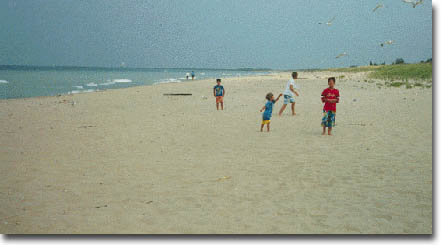
●Rainfall: sewer overflows, storm water runoff, septic systems
●Boating wastes
●Location: land-use, sewers, etc
●Number of users
●Animal wastes


Beach closing information including the beach name, location, and E-coli geometric means were provided by the Oakland County Health Division- Environmental Health Department in tabular format and entered into Excel worksheets. Beach locations and Oakland County boundary line themes were provided in digital format (ArcView 3.2). Rainfall data was obtained from the Oakland County Drain Commissioner’s office. Tables with rainfall from the county’s rain gauge stations and the recorded rainfall at the stations for June and July of 1998 and 2001 was also provided, both in tabular format. Again, Excel was used in order to convert the tabular data into digital, database format. Oakland County street and highway theme layers were obtained from the University of Michigan Map Library and were already in ArcView 3.2.
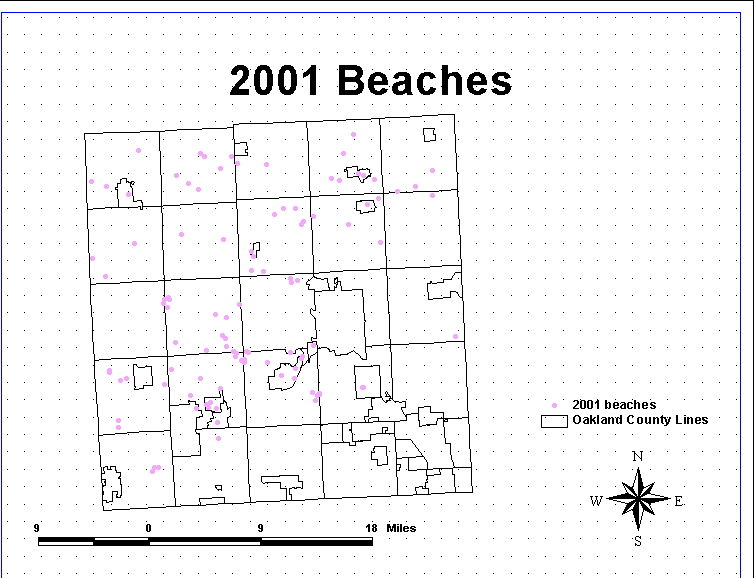
The initial portion of the study was determining the “beach closure days” for June and July of 1998 and 2001. Once this was determined the beaches closed were added to a database table. The rain gauge locations had to be geo-coded as U.S. street addresses using the Oakland County street layers from the Map Library at UM as a reference theme. Eighteen rain gauge stations were located out of the twenty-one present. The rain gauge locations were then saved as a new theme or .shp file. Once the gauge stations were defined, the rainfall at each station was also incorporated into the database tables for a portion of the month of June (when sampling began) through the end of July in 1998 and 2001. The Excel tables were then transferred into ArcView 3.2 as .dbf files. ArcView 3.2 spatial analysis extension was then used which allowed me to determine the rainfall at each closed beach. The rainfall at the closed beaches on the day of the closure was then determined and incorporated into the tables in Excel. Layouts were produced for each day (June-July) showing the spatial analysis determined rainfall distribution for the County and the closed beaches. Graphs using Excel were made to show the rainfall amounts in hundredths of inches and bacteria levels in #E-coli per 100ml.
Hardware: Windows based machine
Software: ArcView 3.2 was used to analyze the rainfall and beach closure data. Microsoft Excel was used to create the data tables of the rainfall and beach closing information. Adobe photoshop was used to format all layouts for web use. Moviegear was utilized to create the animations.
June 1998 Still Frames of Rainfall and Beach Closures:
June 1998 Animation:
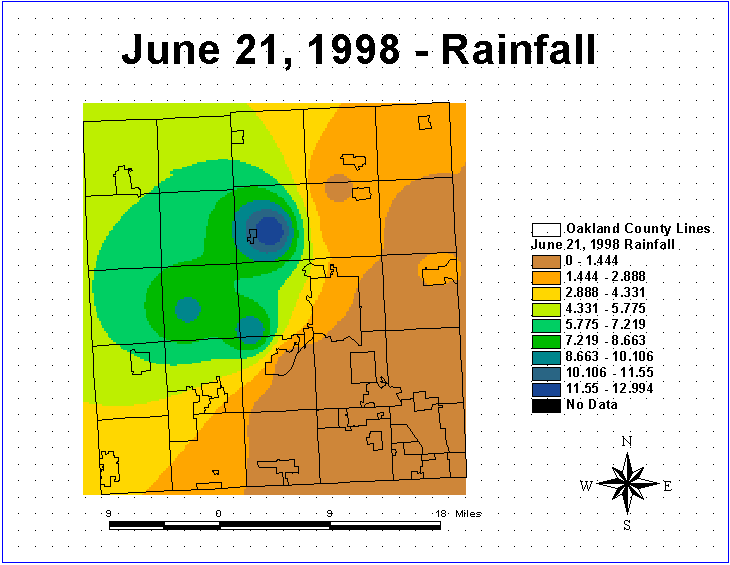
July 1998 Still Frames of Rainfall and Beach Closures:
July 1998 Animation:
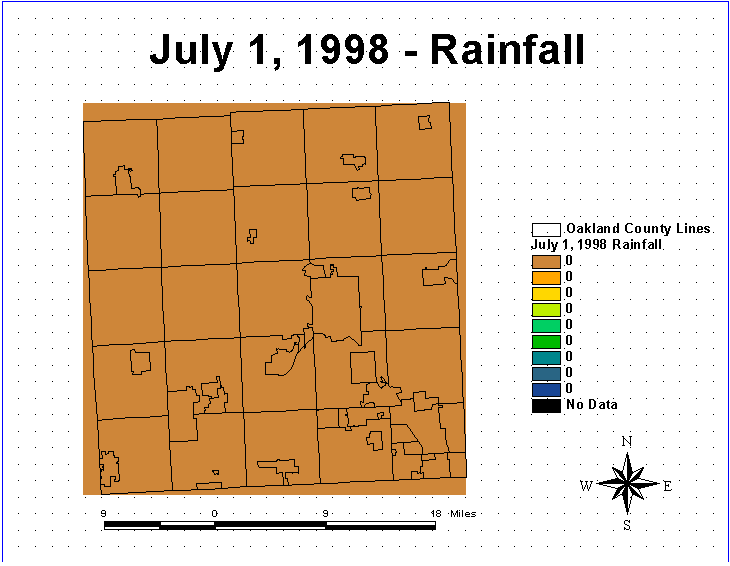
June 2001 Still Frames of Rainfall and Beach Closures:
June 2001 Animation:
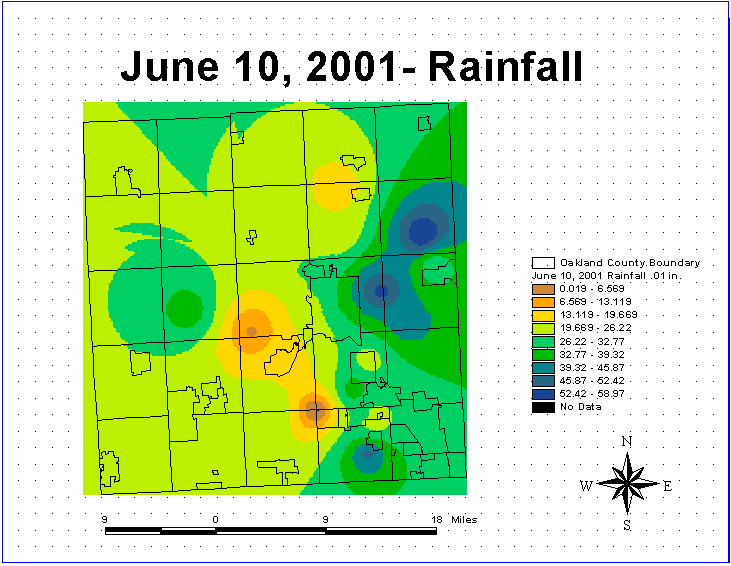
July 2001 Still Frames of Rainfall and Beach Closures:
July 2001 Animation:
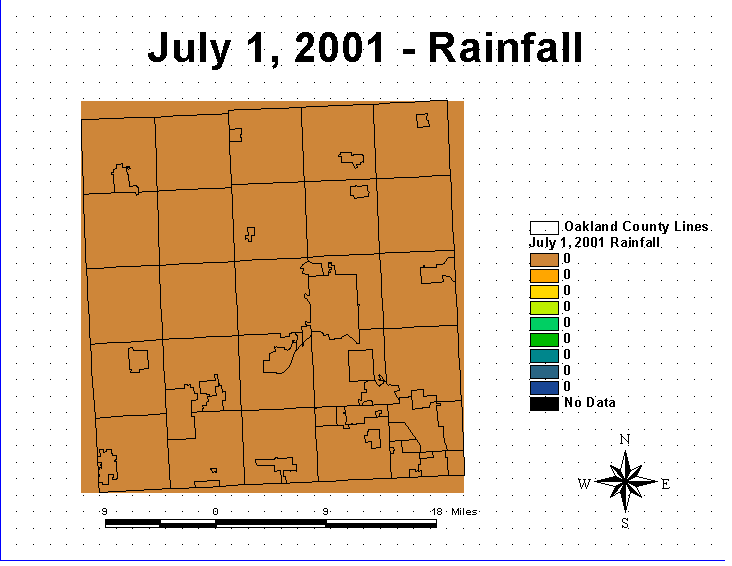
1998: In 1998 there were 49 total beach closures in Oakland County. June had 9 closures with one beach closure day receiving zero inches of rain. July had 40 beach closures with sixteen closure days receiving zero inches of rain. Total average rainfall for June was 1.7 inches. July total average rainfall recorded at the gauge stations was 1.8 inches.
2001: In 2001 there were a total of 29 beaches closed. Twelve beaches were closed in June with 4 closure days occurring on zero inch rainfall days. July had 17 closures with 10 closure days occurring on days with zero inches of rain. The total average rainfall for June and July was 2.6 inches and .90 inches, respectively.
Graphs showing E-Coli/100 ml. versus rainfall (1/100 in.) for the 1998 and 2001 closed beaches are portrayed below. It is evident that there is not a direct correlation between rainfall and beach closures. In fact, the graphs suggest that shorter amounts of rainfall may be more indicative of beach closures. This may make sense because during short rain storms bacteria may just be washed into the beach concentrating near the shore, where as during long storms the bacteria has a chance to disperse further into the lake and not concentrate near the shore and the beach causing the E.Coli levels to diminish. However, most beaches were closed on days that it had rained. Thirty-two of the 49 beaches closed in 1998 and 15 of the 29 beaches closed in 2001 were on "rainy" days. Also, if it had not rained on the beach closure day, most beaches recorded rain measurements on the day prior to the closure. For example, out of the 49 beaches closed in 1998 only 10 of these were closed on days recording 0 inches of rain on both the day prior to the closure and the beach closure day itself. In 2001 there were 5 beaches out of 29 closed that did not receive rain on both the day prior and the day of the closure. This time factor could make a difference because no data was available on the time the beach was sampled, or the time of the rain gauge measurement. It must be stressed that this study only took into account rainfall and many other factors including beach location, proximity to sewers and storm drains, amount of use, and animal activity also have the potential to effect bacterial levels and beach closure.
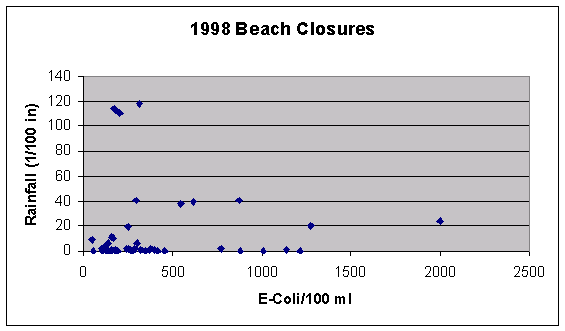
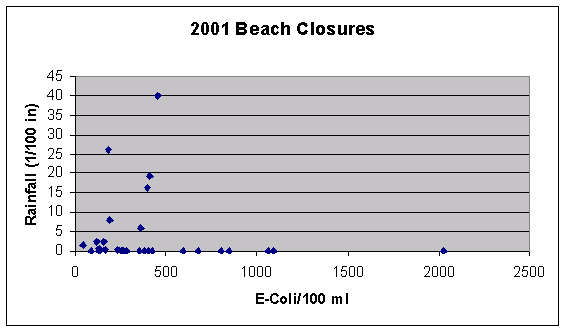
This study is a preliminary first step of many that need to be implemented to study beach closures in Oakland County. An attempt was made to correlate the amount of rainfall with beach closures, but it is evident that many other factors need to be incorporated into a closure model, although it is safe to assume that rain does play a role in beach closures. Other factors such as proximity to septic systems and storm water drains, land use patterns (agricultural vs. industrial), and animal activity could also be implemented into this study to provide further input into the exact causes of closures. It is apparent that most beaches are closed either on the day of significant rainfall, or the day after, so some sort of time factor should also be included. Since only a minimal number of closures occurred on days when it did not rain, or one day after a significant rain event, one can conclude that it is safer to avoid swimming for at least one day after the rain event in order to allow bacterial levels to subside.
Environmental Protection Agency. “Beach Act.” www.epa.gov/OST/beaches .
25jul2001: 1-16
Environmental Protection Agency. “Beach Watch, Frequently Asked Questions.”
www.epa.gov/OST/beaches/faq.html . Access 25 Feb 2002: 1-6.
Crowther, J., Kay, D., and M. Wyer. “Relationships Between Microbial Water
Quality and Environmental Conditions.” Water Research. V35n17 (Feb2001):
4029-2038.
Armstrong, I., Higham, S., Hudson, G. and T. Colley. “The Beachwatch Pollution
Monitoring Programme: Changing Priorities to Recognize Changed
Circumstances.” Marine Pollution Bulletin. V33n7-12: 249-259.
.